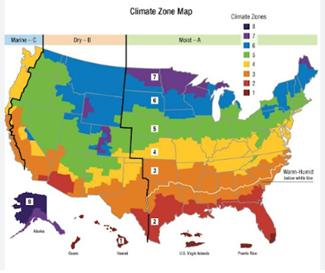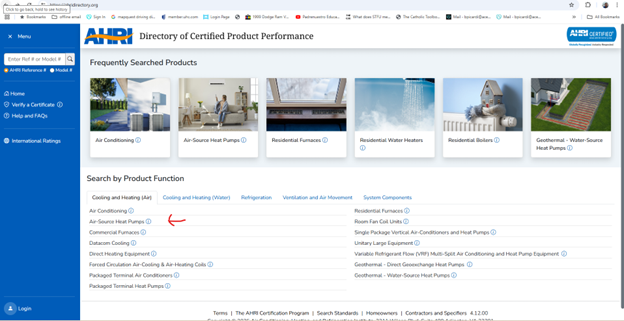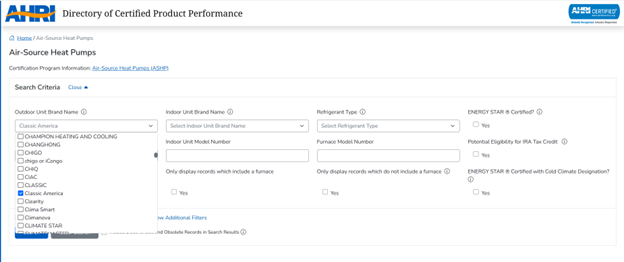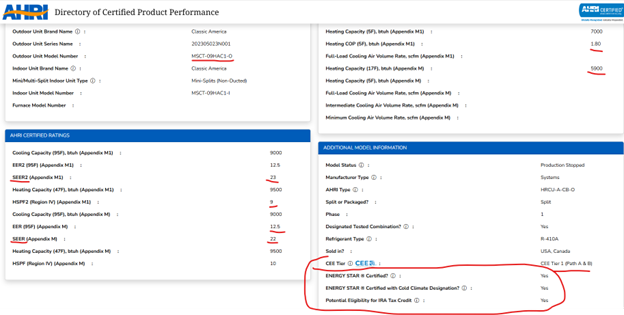WHY ARE THERE SUCH SHARP DIFFERENCES IN PRICE BETWEEN MINI SPLITS???- AREN'T THEY ALL BASICALLY THE SAME?????
Published by Bert on May 30th 2025
OK, so how do I choose among the maaaany mini splits makes and models? And with such wide price differences????
Well, if you are one of those people who doesn’t buy a car on a whim, (or because of its color) but first do a lot of research and comparisons on fuel consumption, reliability data, etc., here are some things to consider and compare:
Other than reviews (which as you know, may disproportionately reflect people who are disgruntled and want to be heard), spend some time understanding what the different certifications and ratings mean. Often, they account for price differences (the more certifications, the higher the ratings, the higher the price). Most of the certifications have to do with safety, reliability and efficiency and independent verification of Manufacturers’ claims with respect to those.
Spend some time comparing these ratings as you decide on purchasing a new unit. They will affect your pocket via the utility bills!! And repair costs.
Meaning of Updated Ductless Mini Split Heat pump and Air Conditioner Ratings: EER, CEER, SEER, SEER2, HSPF2 and Tax rebates!!
If you look at our listings you will notice a few old and a few new acronyms: EER, CEER, HSPF (Region X) COP and SEER have been around for quite some time. Recently, you will see these same acronyms but with a 2 after them, like SEER2, EER2, etc. What does that mean???? Well, the old ratings were the result of testing by third party labs against a 2017 AHRI (Air Conditioning, Heating and Refrigeration Institute) standard. And the ratings with the 2 at the end respond to tests to a stricter 2023 standard from the same institute.
Note that not all ratings apply to all types of units. For example, Window air conditioners that only cool, do not have a SEER/SEER2 rating, but a CEER rating, but many of these ratings measure energy efficiency under some conditions. A few of the ratings evaluate how well the heating function will behave at low temperatures. And some even have tax rebate implications!!
Here is a brief explanation of what some of the ratings mean. Remember, if they have a ‘2’ at the end the rating is against the often stricter 2023 standard! No ‘2’ at the end, the rating is against the 2021 standard.
- EER: Measures the efficiency at a specific temperature of 95°F. The higher the EER, the higher efficiency.
- CEER: Accounts for both operating and standby power usage, providing a realistic measure of room air conditioner efficiency. It is used for units that only cool (no heat), such as our window air conditioners.
- SEER: Measures seasonal efficiency during the cooling season. The higher the efficiency, the higher the SEER. It is used for units that cool and heat, but measures the efficiency during the estimated cooling season ONLY. The department of Energy mandates the minimum SEER ratings by region. As of 2024 these were:
- Northern states: 14 SEER (13.4 SEER2)
- Southern states (Southeast): 15 SEER (14.3 SEER2)
- Southwestern states: 15 SEER (14.3 SEER2)
Generally, mini splits have much higher SEER ratings than the minimums because the new ones use Inverter compressor control (they don’t just turn the compressor or on or off, they ‘modulate’ the compressor speed according to the need, typically from 15%-100%). It’s rare to find the older, lower SEER, non inverter, ON-OFF models but, once again, you’d be surprised what you find in the market!
- HSPF: Measures the seasonal heating efficiency of heat pumps. The ratings depend on models of several regions, so you will sometimes see “HSPF (Region X)” or “HSPF2 (Region X)”. If no region is specified, by default, region 4 (IV) is implied. Region 4 (IV) is roughly a “belt” across the United States between north and South. Here below are the regions (For heating efficiencies). A rating for Region 5(V) is important for the colder weather!

Heating Seasonal Performance Factor 2 (HSPF2)2F 4: HSPF2 is the total space heating required in region IV during the space heating season, expressed in Btu, divided by the total electrical energy consumed by the heat pump system during the same season, expressed in watt-hours. The represented value of HSPF determined in accordance with Appendix M1 is HSPF2, and the represented value in accordance with Appendix M is HSPF. K. Seasonal Energy Efficiency Ratio 2 (SEER2)4: SEER2 is the total heat removed from the conditioned space during the annual cooling season, expressed in Btu, divided by the total electrical energy consumed by the air conditioner or heat pump during the same season, expressed in watt-hours. The represented value determined in accordance with Appendix M1 is SEER2, and the represented value in accordance with Appendix M is SEER. L. Energy Efficiency Ratio 2 (EER2)4: EER2 is the ratio of the average rate of space cooling delivered to the average rate of electrical energy consumed by the air conditioner or heat pump. This ratio is expressed in Btu per Wh (Btu/Wh). The represented value determined in accordance with appendix M1 is EER2, and the represented value determined in accordance with Appendix M is EER. M. Coefficient of Performance (COP)2: COP means the ratio of the average rate of space heating delivered to the average rate of electrical energy consumed by the heat pump. These rate quantities must be determined from a single test or, if derived via interpolation, must be determined at a single set of operating conditions. COP is a dimensionless quantity
What is the difference between the standard ENERGY STAR® Certification and the ENERGY STAR® Cold Climate Designation?
The ENERGY STAR® Cold Climate Designation denotes a Cold Climate Heat Pump, which is intended to be used in very cold conditions such as those found in the North and Canada. The standard ENERGY STAR® Certification and the ENERGY STAR® Cold Climate Designation have different qualifications. The standard ENERGY STAR® Certification establishes thresholds that must be met for efficiency ratings such as SEER2, EER2, and HSPF2. The ENERGY STAR® Cold Climate Designation establishes thresholds that must be met for SEER2, HSPF2, and low ambient (5 degree F) performance characteristics. A model may not be certified to the standard ENERGY STAR® Certification or the ENERGY STAR® Cold Climate Designation, may be certified to one and not the other, or certified to both.
Complete eligibility criteria for both the standard ENERGY STAR® Certification and the ENERGY STAR® Cold Climate Designation can be found in version 6.1 of the ENERGY STAR® Program Requirements Product Specification for Central Air Conditioner and Heat Pump Equipment.
What is CEE?
The Consortium for Energy Efficiency (CEE) is a group of North American utility energy efficiency program administrators. Consortium members develop cutting-edge strategies to accelerate the commercialization of energy-efficient solutions to benefit gas and electric customers, utility systems, and the environment. In this work, CEE engages with leading manufacturers, trade associations, and other market stakeholders to develop solutions that benefit all. Consortium work is guided by Initiatives that members voluntarily implement.
Within the context of an initiative, CEE specifications set tiers, or definitions of energy performance, for a product or service. The initiative scopes other aspects, such as variation in performance related to weather. The tier strategy becomes the basis for market transformation. An initiative may require more than one specification.
The AHRI Directory of Certified Product Performance identifies residential and small commercial air conditioners and air-source heat pumps, and residential and commercial furnaces, water heaters, and boilers qualifying for CEE initiatives and meeting CEE specifications.
For questions regarding CEE, CEE initiatives, and CEE specifications, please visit https://cee1.org/contact/.
How do I know if manufacturer claims regarding efficiency and operation are true?
AHRI checks that for you.
Is AHRI certification mandatory? No, but highly recommended. If you go into their directory at
https://ahridirectory.org/ and click on Air Source Heat Pumps
Directory of Certified Product Performance

And plug in the brand name, you will get an idea of what the TRUE operating and efficiency characteristics are of any minisplit that has been tested and certified by this body. The certificate will also contain information on Energy Star ratings.

For example, for ours you will get this (9000 BTU model shown)

Other certifications and why they are important:
Is it going to interfere with my other wireless devices?? Does it have an FCC ID? (ISED Cert # and HVIN # in Canada)
Wi Fi enabled units need to comply with FCC regulations, Part 15, regarding interference. This part sets out the regulations under which an intentional, unintentional, or incidental [radio frequency] radiator may be operated without an individual license. Certification labels may be used only where the authorization has involved an application to the FCC and subsequent approval. These carry no graphics at all, just words and the FCC ID number, which the commission uses to track the party responsible. The ID number consists of a three-character Grantee Code (assigned by the FCC upon request) and up to 14 additional alphanumeric characters of the applicant's choosing. It is illegal to sell items that communicate over Wi Fi and do not comply with these regulations, but you’ll be surprised to find some on the market!! In Canada, the body regulating is the ISED.
Is it electrically safe?
These units must be tested to UL Standards 60-335-1 and 60-335-2-40. They can be tested by either UL laboratories themselves or by ETL Intertek (in theory they can be tested for compliance by any “ Nationally Recognized Testing Laboratory”, but these two are the most common). If they pass the test they are marked so on the boxes. In most US jurisdictions it is illegal to install appliances that do not have this certification but, once again, you’ll be surprised to find some on the market.
Noise ratings:
Many communities and Home Owners Associations establish a limit on noise producing devices during certain hours of the night. Sound level is measured in decibels (dB) or in dB(A) (decibels adjusted for human hearing). The outdoor unit makes noise when it’s running to provide heating or cooling. If you have neighbors close by or live in an apartment building, make sure you compare decibel ratings (and ensure you are below any mandated levels by your community rules or HOA). While most units have similar outdoor unit sound levels, once again, you'd be surprised what you can find in the market!!
If you have any questions, feel free to call our tech support at 1-800-349-4360

